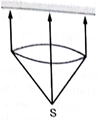A totally reflecting, small plane mirror placed horizontally faces a parallel beam of light as shown in figure. The mass of the mirror is 20g. Assume that there is no absorption in the lens and that 30% of the light emitted by the source goes through the lens. Find the power of the source needed to support the weight of the mirror. Take g = 10 m s–2.

The weight of the mirror is supported by the light.
The weight of mirror =mg.
Force exerted on mirror is, as mirror is fully reflecting and 30% of light which is passed through the lens is used
From equation 1 of question 6 we can write
![]()
we light fall at angle θ on mirror
taking derivative of above equation and putting θ =0 as perpendicular it is falling we get
![]()
Where ![]() =power and
=power and ![]() =force ,c =speed of light.
=force ,c =speed of light.
∴ we get
Force = ![]()
∴ The force exerted by light is = ![]() .
.
And the power of light which is used is only 30% of original
→ for mirror to be in equilibrium the downward force and upward force must be equal.
The weight acting downwards = the force exerted by light
Weight acting downwards =Mg
Force exerted by light=![]()
As only 30% of light is fall on mirror, therefore only 30% of the power is in use.
Force exerted by light=![]()
![]()
Where M= mass,
g = acceleration due to gravity.
Putting the values,
20×![]() × 10=2
× 10=2 ![]() .
.
Hence, power is =![]() =100MW.
=100MW.